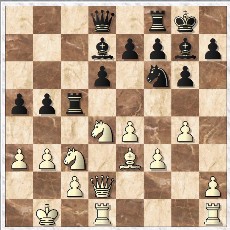Worcestershire Chess Association

Worcestershire Chess Association |
 |
Published 6 September 2016
|
Woodcock prize 2016Worcs Chess League Division 1 match: Malvern - HalesowenPlayed on Board 2 at Malvern on 18 March 2016. Notes by the winner. One of the adjudicators for the prize wrote: "In my opinion, it's a very high quality game. White finds one excellent move in particular (17.Ne6!), but Black plays his part in making the game as a whole entertaining. ... The critical line that black missed at move 18 is sufficiently murky ... for the approach taken by white on move 17 to be genuine risk-taking". White: Geoff Marchant (Malvern) 1. e4 c5 2. Nf3 d6 3. d4 cxd4 4. Nxd4 Nf6 5. Nc3 g6 6. Be3 Bg7 7. f3 Nc6 8. Qd2 O-O 9. Bc4 Bd7 10. O-O-O Rc8 11. Bb3 Ne5 12. Kb1 a5 (12... Re8 or 12... Nc4 are possible) 13. a3 (13. a4!? Nc4 14. Bxc4 Rxc4 15. b3 Rc8 16. Ndb5 Be6 17. h4 h5 18. Bd4 Qd7 19. Rhe1 Kh7 20. Re2 (20. Nd5! looks possible at once: Nxd5 21. Bxg7 Kxg7 22. exd5 Bf5 23. Nd4±) 20... Qd8 21. Nd5 Nxd5 22. Bxg7 Kxg7 23. exd5 Bd7 24. Nd4± Lanka - Bindrich, Leutersdorf 2001) 13... Nc4 14. Bxc4 Rxc4 15. g4 b5 ... after a long thought 16. b3 challenging the rook is a good idea, as it happens (16. Ndxb5 Qb8 17. Nd4 Rfc8 appears to give Black plenty of initiative for the pawn. I did seriously consider 16. Qd3 Qb8 17. Nb3 (17. Ndxb5? Bxb5 18. Nxb5 Qxb5 19. b3 Rfc8 and White has given up a piece for nothing) 17... a4 18. Nd2 Rc7) 16... Rc5 (16... Rc8 is possible, but 16... Rxc3?! 17. Qxc3 should be fine for White)
 Marchant - Edge, Position after 16...Rc5
17. Ne6! I was quite pleased to have found this move! 17...fxe6 18. Bxc5 Qc7 (Taking the bishop is the critical line: 18...dxc5 19. e5! (I had thought that 19. g5 was an equivalent move but, in fact, Black has another resouce in this case: 19...Ne8 20. Nxb5 Nc7 21. a4 (21. Nxc7 Qxc7 22. Qxd7 looks very dangerous after Qe5) 21... Nxb5 22. axb5 Bd4 23. c3 e5 24. cxd4 cxd4 despite being the exchange down, Fritz 11 prefers Black here!) 19... Nd5 20. Nxd5 Bxe5 (I had spotted that 20... Bc6?? loses to 21. Nf6+ and 20... exd5?? fails to 21. Qxd5+) 21. Nxe7+ Qxe7 22. Qxd7 Black can still play on as White's king is a little unsafe but White should be able to consolidate 22...Qxd7 (22... Qf6 23. g5! Qf5 24. Qxb5) 23. Rxd7 Rxf3 24. Rb7 b4 25. Ra7 bxa3 26. Rxa5) 19. Bd4 Rc8 20. Ne2 (20. g5!? Nh5 (20...e5? 21. gxf6 Bxf6 22. Nd5 +-) 21. Bxg7 Kxg7 22. Kb2) 20... a4? (20... e5 is better) 21. g5! Nh5 22. Bxg7 Nxg7 23. Rhf1 Qc5 (during the game I was worried about 23... b4? but 24. axb4 a3 (24... axb3 25. cxb3 is also fine for White) 25. c4! is fine for White) 24. b4 Qe5 25. Ng3! another move I was pleased to find 25...Ne8 26. f4 Qg7 27. Qd4 (or 27. f5) 27... Rc4 28. Qxg7+ Nxg7 29. Kb2 (I did consider 29. e5 but didn't evaluate it correctly 29...d5 30. Kb2 Kf7 31. Rd3 Ke8 32. Rff3 Bc6 33. Rc3 +-) 29... Bc6 30. f5?! (30. Rde1 is safer, but by this time my opponent was in considerable time trouble and I wanted to play more challenging moves that might make him spend time thinking!) 30... exf5 (I saw the variation 30...Bxe4 31. Nxe4 Rxe4 32. f6 exf6 33. Rxd6 Nf5 34. Rd8+ (34. Rb6 is probably better) 34... Kf7 35. Rd7+) 31. exf5 gxf5 32. Nxf5 Nxf5 33. Rxf5 Rxc2+ I missed this move, but it does simplify the position for me 34. Kxc2 Be4+ 35. Kc3 Bxf5 36. Kd4 Kf7 (I had thought 36... e6? {was playable to keep the king out but 37. Rc1 and the rook penetrates) 37. Kd5! Be6+ (37... Bd7 38. Rf1+ Kg7 39. Rf4 Kg6 40. h4 Kg7 41. h5 +-) 38. Kc6 Bc4 39. Re1 Bd3 40. Re3 Bc4 41. Kd7 d5 42. h4 e6 my opponent had played good moves extremely quickly to reach the time control; I really did think I might win on time. 43. Rf3+ (43. Rxe6 is better) 43... Kg6 I had sealed 44. Kxe6 but my opponent resigned without resumption. 1-0 A possible continuation was 44. Kxe6 d4+ (44... Kh5 45. Rf4 d4+ 46. Ke5 d3 47. Rd4 Kg6 48. Kf4 (or 48. Rd7 h5 49. Kf4 and Black has to move the bishop or d pawn, meaning that pawn is doomed)) 45. Ke5 d3 46. Rf6+ Kg7 (46... Kh5 47. Kf4! threatens 48. Rh6) 47. h5 d2 48. Rd6
|